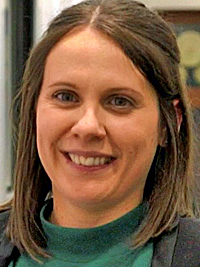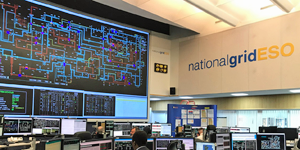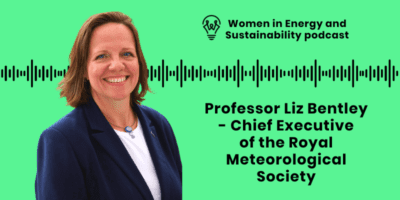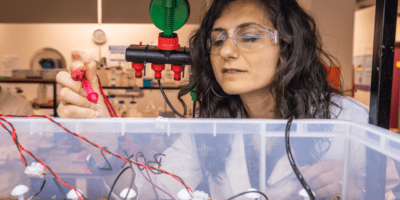Amy Weltevreden is market requirements senior manager at National Grid ESO. She has a mathematics degree from the University of Warwick, and after joining National Grid’s Graduate Development Programme she undertook various analytical roles during her first few years with the company. Amy is now responsible for the team that helps the organisation safely and voluntarily flex the electricity supply in real-time.

“Divesity of thought as well as hearing a range of views and opinions are some of the most satisying parts of my role – if you find yourself in a room without debate you’re in the wrong room (or you need to get some fresh voices into it!).”
Keeping the lights on
I joined National Grid as a graduate of their development programme in 2012, having completed a BSc degree in Mathematics at the University of Warwick. I had no idea what I wanted to do but was interested in using my STEM background in some way to contribute to solving the climate crisis.
I applied to a number of roles at energy companies and was lucky enough to end up at an organisation at the heart of Great Britain’s decarbonisation, which also plays a critical role every day in keeping the lights on. I’ve worked here for a decade now and have been fortunate enough to have moved around the business, starting out as a commercial analyst, spending time in business performance and improvement roles, before focusing the last four years of my career on commercial operations.
Pulling the right levers
National Grid ESO stands for National Grid Electricity System Operator. It is a separate business from National Grid [Electricity Transmission], with both operating as part of the National Grid group.
At National Grid ESO I currently lead the team responsible for ensuring our control room has the right levers to pull in real-time to manage the risks they face in operating the system safely, securely and at least cost to consumers. This is a rapidly changing space given the changing generation mix, so my team are also responsible for the technical design of new products and services to balance the system as new technologies seek to participate in the markets we operate.
Real-time balancing of electricity supply and demand
Whilst others are responsible for owning, maintaining and developing the physical infrastructure across the country, the ESO as the system operator is responsible for the real-time balancing of electricity supply and demand. This means second-by-second monitoring of the electricity network to ensure you can always access the power you need when you need it.
This is a complex engineering problem every single day, as we need to make sure that the physical parameters of the system are in line with strict limits so that electricity can flow across the country 24/7 and safely. A lot of our role is risk management, so the focus is on anticipating what could happen and then delivering a plan to mitigate any risks.
An evolving energy mix

Alongside this, we’re also seeing rising solar generation and interconnection with other countries, which has ultimately enabled us to rapidly transition away from coal and reduce how much electricity also needs to be generated from gas.
This change in technologies also brings about new power system problems to solve, as the physical dynamics of the system still need to be kept in balance at all times. Working through how we meet requirements for things like voltage and inertia (which are critical to maintaining the quality of our electricity supply) using these new technologies is one of many problems we are working hard on.
This isn’t just an engineering problem, there are economic and commercial problems to solve, to ensure we create the best value outcomes for consumers too. In particular, this means creating new routes to market, as we move from a world with a handful of dominant market players, to one with hundreds of companies operating assets with different business models.
Voluntarily and safely flexing the time of electricity use
The Demand Flexibility Service (DFS) is part of a range of tools designed to help manage the electricity system this winter and gives us access to additional flexibility when national demand is at its highest. This new innovative service allows consumers, as well as some industrial and commercial users (through suppliers/aggregators), to be incentivised for voluntarily and safely flexing the time when they use their electricity.
This is the first time these groups have had direct involvement in electricity balancing and is hopefully the foundation of an electricity future where consumers particularly can be rewarded for more flexible use of electricity.
We’d encourage the Womanthology community in the UK to support the service. Our approved list of DFS providers is available on our website, which includes links to take you to the right place to get started. Your energy supplier may be offering this service to you already and if not, there are a number of third parties you can sign up with to participate in the service as well.
Using a diverse set of perspectives to solve complex problems
There are so many complex problems we need to solve in this sector that we need a diverse set of perspectives to explore the best solutions to solve them. Whilst being technically challenging, many of these problems also cut across human factors too and so there are often conflicts that need to be navigated in finding the best outcome overall. So, we have to make sure that these ranging viewpoints are represented and consideration given to allow compromises to be found. And most importantly, energy is the lifeblood of our society – we all need it.
To serve our customers and society as best we can, we have to have a workforce that represents those we serve and can advocate on their behalf. Diversity of thought as well as hearing a range of views and opinions are some of the most satisfying parts of my role – if you find yourself in a room without debate, you’re in the wrong room (or you need to get some fresh voices into it!).
Get switched on to powerful careers
I’d encourage girls and women interested in careers in the energy sector to check out our opportunities at National Grid ESO. We are recruiting for a range of roles at the moment for all stages of your career.
We have a range of training programmes available, from apprenticeships to graduate programmes, as well as seeking to recruit experienced hires with transferrable skills across a wide range of roles. If you have enthusiasm, are eager to learn and looking to join a purpose-driven organisation at the heart of the energy system, we are the company for you!
I’d also suggest signing up for one of the many women in energy networking groups. For example, the Women’s Utilities Network – these are great opportunities to meet women in the sector currently and to learn about the many varied and fascinating roles they all do.
(Next) winter is coming…

Day-to-day, we’re continuing to manage throughout the winter and ensure a reliable electricity supply to consumers each day. We’ve also begun planning for next winter and are actively reviewing the demand flexibility service to see how we might seek to use it in the future.
We’re keen to explore how this service can continue, to encourage shifting of demand during cold, winter days, but also the potential for such a service during summer months or periods of excess renewable generation. This would be the next step in creating opportunities for consumers to be rewarded for flexible consumption that will hopefully evolve into a daily and automated solution to help reduce consumer bills.





